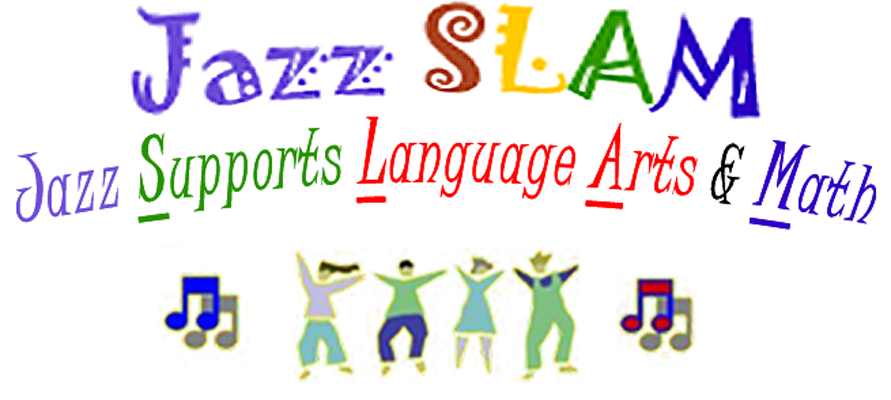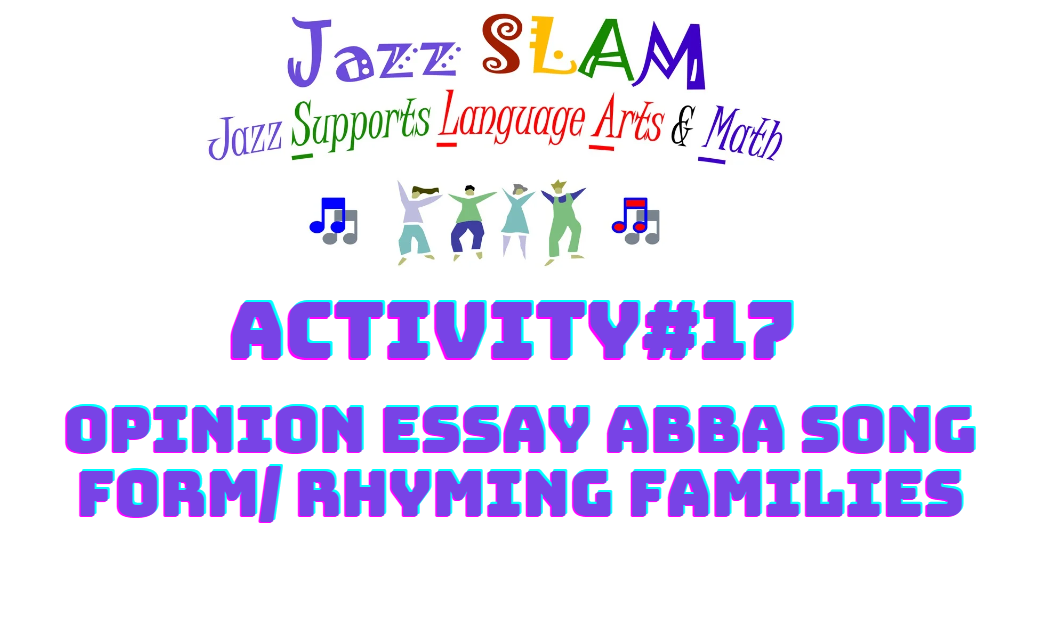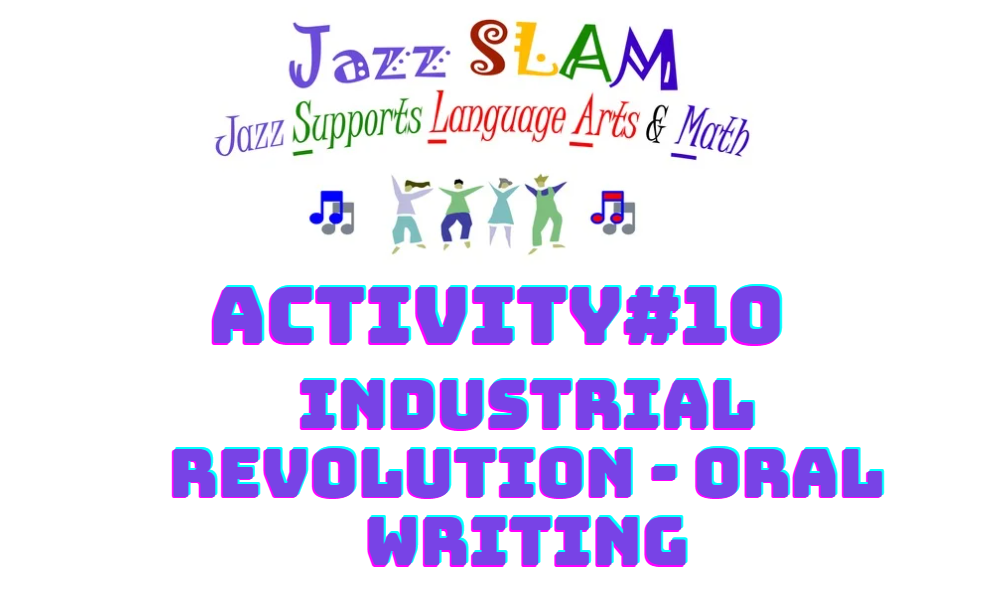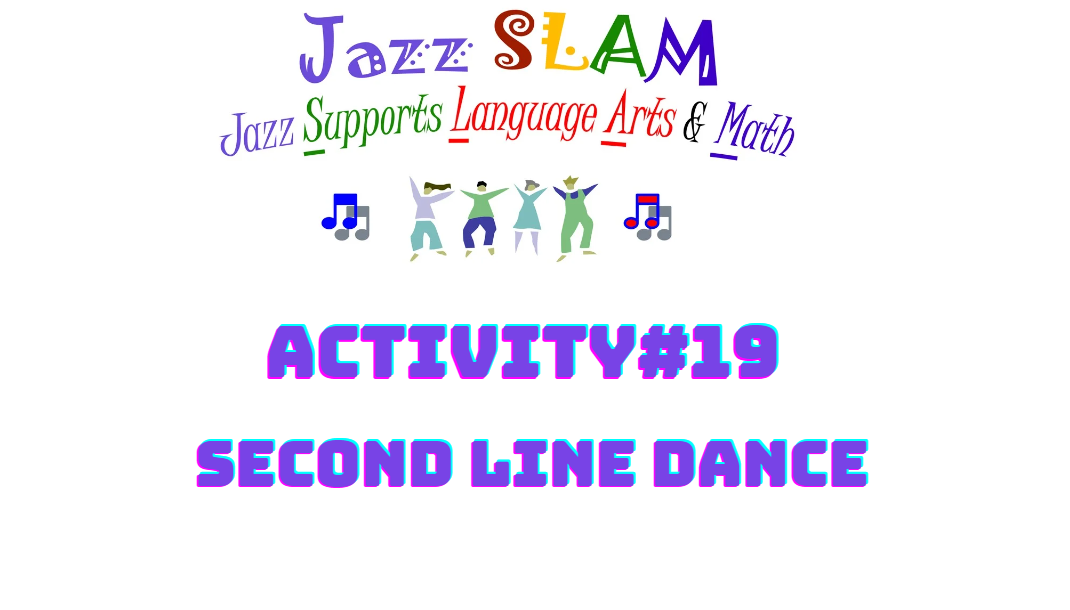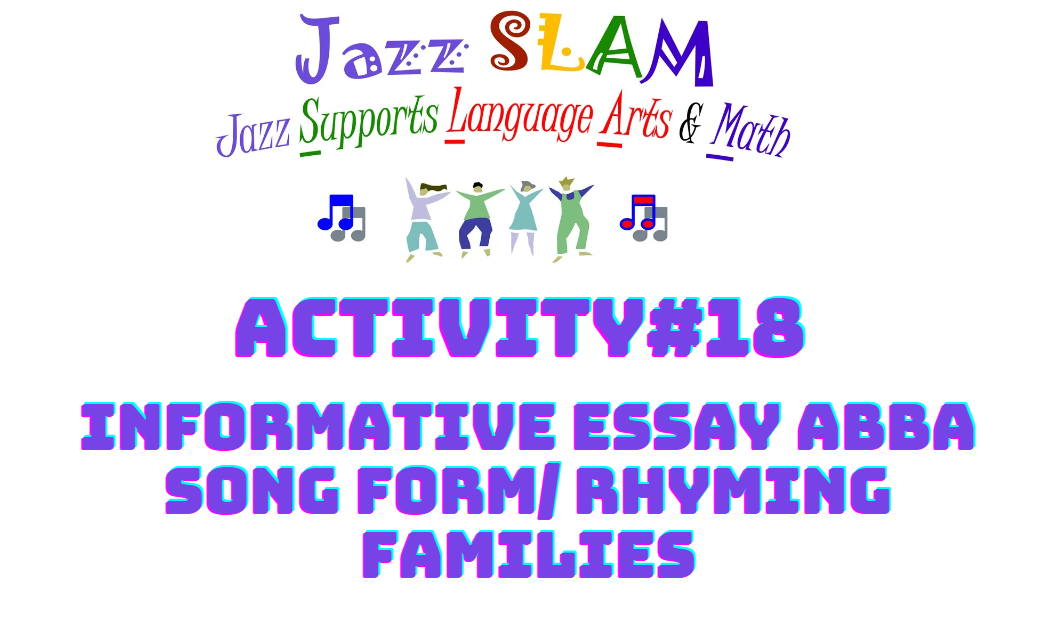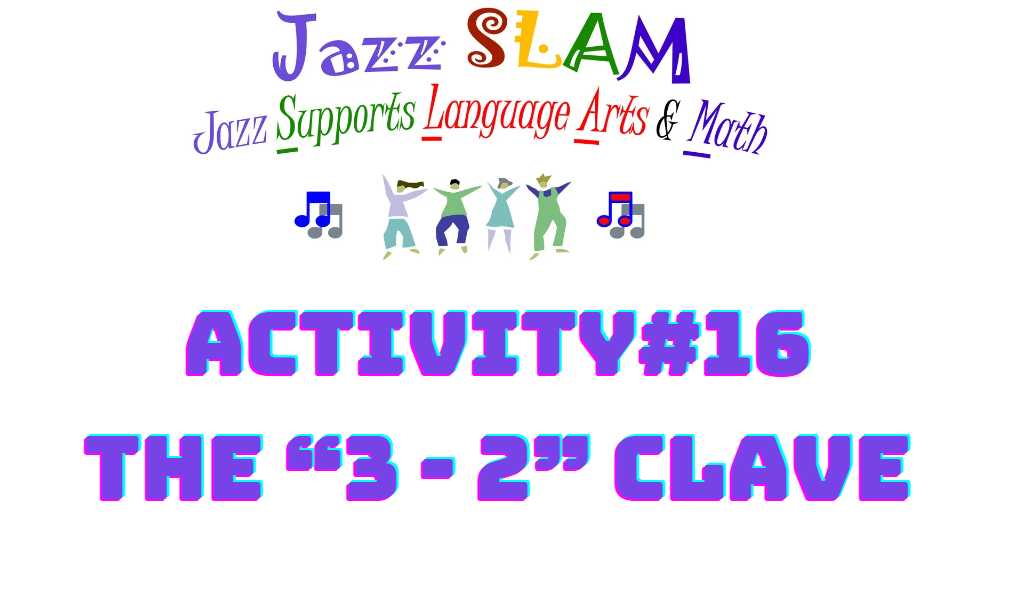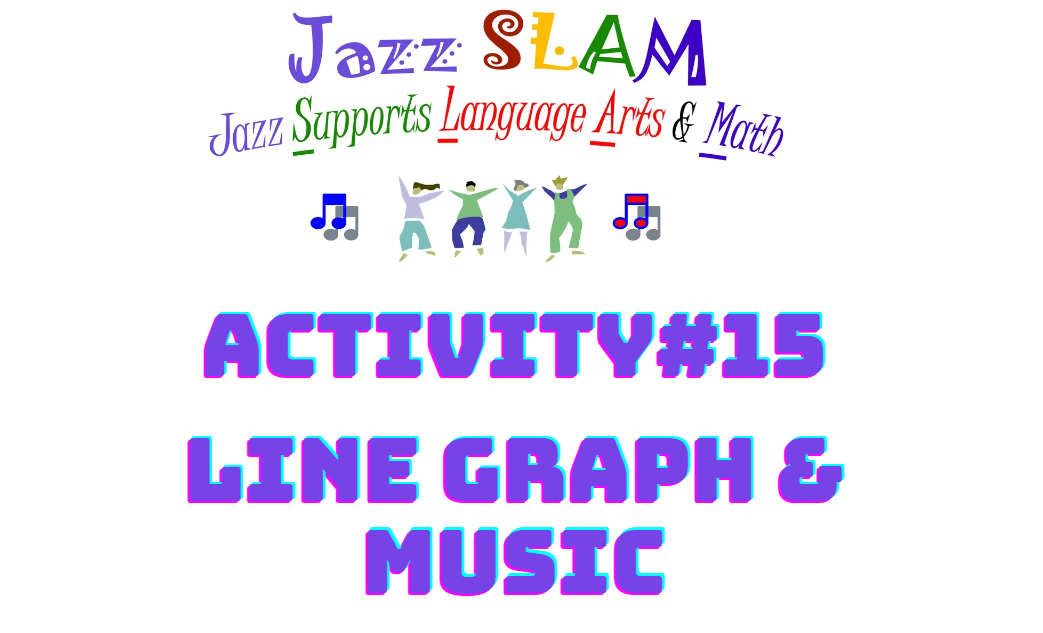About This Lesson
Learning Goals/Objectives
STUDENTS WILL BE ABLE TO:
- Describe ABBA form
- Write to make a claim supporting a perspective with logical reasons, using evidence from multiple sources
- Improve writing by planning, revising, and editing, with guidance and support from adults
- Bonus: Students will be able to clap the 3-2 clave while listening to “Under the Sea”
Materials/Additional Resources
- Paper
- Pencil
- “Under the Sea” from the little Mermaid= ABBA (Chorus-Verse-Chorus-Verse-Chorus) note the extra A thrown in the middle
Common Core Standards & NGSSS Music Standards
Common Core Standards
RL.3.2 Recount stories, including fables, folktales, and myths from diverse cultures; determine the central message, lesson, or moral and explain how it is conveyed through key details in the text.
RL.3.3 Describe characters in a story (e.g., their traits, motivations, or feelings) and explain how their actions contribute to the sequence of events.
RL.3.5 Refer to parts of stories, dramas, and poems when writing or speaking about a text, using terms such as chapter, scene, and stanza; describe how each successive part builds on earlier sections.
W.3.1 Write opinion pieces on topics or texts, supporting a point of view with reasons.
W.3.4 With guidance and support from adults, produce writing in which the development and organization are appropriate to task and purpose.
W.3.5 With guidance and support from peers and adults, develop and strengthen writing as needed by planning, revising, and editing.
SL.3.1 Engage effectively in a range of collaborative discussions (one-on-one, in groups, and teacher-led) with diverse partners on grade 3 topics and texts, building on others’ ideas and expressing their own clearly.
SL.3.4 Report on a topic or text, tell a story, or recount an experience with appropriate facts and relevant, descriptive details, speaking clearly at an understandable pace.
SL.3.6 Speak in complete sentences when appropriate to task and situation in order to provide requested detail or clarification.
L.3.1 Demonstrate command of the conventions of standard English grammar and usage when writing or speaking.
L.3.2 Demonstrate command of the conventions of standard English capitalization, punctuation, and spelling when writing.
L.3.3 Use knowledge of language and its conventions when writing, speaking, reading, or listening.
L.3.5 Demonstrate understanding of word relationships and nuances in word meanings.
RL.4.5 Explain major differences between poems, drama, and prose, and refer to the structural elements of poems (e.g., verse, rhythm, meter) and drama (e.g., casts of characters, settings, descriptions, dialogue, stage directions) when writing or speaking about a text.
L.4.1 Demonstrate command of the conventions of standard English grammar and usage when writing or speaking.
L.4.2 Demonstrate command of the conventions of standard English capitalization, punctuation, and spelling when writing.
L.4.3 Use knowledge of language and its conventions when writing, speaking, reading, or listening
L.4.5 Demonstrate understanding of word relationships, and nuances in word meanings.
W.4.1 Write opinion pieces on topics or texts, supporting a point of view with reasons and information.
RI.5.10 By the end of the year, read and comprehend informational texts, including history/social studies, science, and technical texts, at the high end of the grades 4–5 text complexity band independently and proficiently.
RL.5.2 Determine a theme of a story, drama, or poem from details in the text, including how characters in a story or drama respond to challenges or how the speaker in a poem reflects upon a topic; summarize the text.
RL.5.3 Compare and contrast two or more characters, settings, or events in a story or drama, drawing on specific details in the text (e.g., how characters interact).
RL.5.4 Determine the meaning of words and phrases as they are used in a text, including figurative language such as metaphors and similes.
L.5.1 Demonstrate command of the conventions of standard English grammar and usage when writing or speaking.
L.5.2 Demonstrate command of the conventions of standard English capitalization, punctuation, and spelling when writing.
L.5.3 Use knowledge of language and its conventions when writing, speaking, reading, or listening
L.5.5 Demonstrate understanding of figurative language, word relationships, and nuances in word meanings.
RI.5.5 Compare and contrast the overall structure (e.g., chronology, comparison, cause/effect, problem/solution) of events, ideas, concepts, or information in two or more texts.
RI.5.10 By the end of the year, read and comprehend informational texts, including history/social studies, science, and technical texts, at the high end of the grades 4–5 text complexity band independently and proficiently
RL.5.2 Determine a theme of a story, drama, or poem from details in the text, including how characters in a story or drama respond to challenges or how the speaker in a poem reflects upon a topic; summarize the text.
RL.5.4 Determine the meaning of words and phrases as they are used in a text, including figurative language such as metaphors and similes.
RL.5.5 Explain how a series of chapters, scenes, or stanzas fits together to provide the overall structure of a particular story, drama, or poem
W.5.1 Write opinion pieces on topics or texts, supporting a point of view with reasons and information.
W.6.1 Write arguments to support claims with clear reasons and relevant evidence.
W.6.4 Produce clear and coherent writing in which the development, organization, and style are appropriate to task, purpose, and audience. (Grade-specific expectations for writing types are defined in standards 1–3 above.)
W.6.5 With some guidance and support from peers and adults, develop and strengthen writing as needed by planning, revising, editing, rewriting, or trying a new approach.
SL.6.6 Adapt speech to a variety of contexts and tasks, demonstrating command of formal English when indicated or appropriate.
L.6.1 Demonstrate command of the conventions of standard English grammar and usage when writing or speaking.
L.6.2 Demonstrate command of the conventions of standard English capitalization, punctuation, and spelling when writing.
L.6.3 Use knowledge of language and its conventions when writing, speaking, reading, or listening.
L.6.5 Demonstrate understanding of figurative language, word relationships, and nuances in word meanings.
NGSSS Music Standards
MU.3.C.2.1 Evaluate performances of familiar music using teacher-established criteria.
MU.3.F.1.1 Enhance the meaning of a story or poem by creating a musical interpretation using voices, instruments, movement, and/or found sounds.
MU.3.F.3.1 Collaborate with others to create a musical presentation and acknowledge individual contributions as an integral part of the whole.
MU.3.H.3.1 Experience and discuss, using correct music and other relevant content-area vocabulary, similarities in the use of pattern, line, and form in music and other teacher selected contexts.
MU.3.O.1.1 Identify, using correct music vocabulary, the elements in a musical work.
MU.3.O.3.1 Describe how tempo and dynamics can change the mood or emotion of a piece of music.
MU.3.S.2.1 Identify patterns in songs to aid the development of sequencing and memorization skills.
MU.3.S.3.1 Sing rounds, canons, or ostinati in an appropriate range, using head voice and maintaining pitch
MU.4.C.2.1 Identify and describe basic music performance techniques to provide a foundation for critiquing one's self and others.
MU.4.F.1.1 Create new interpretations of melodic or rhythmic pieces by varying or adding dynamics, timbre, tempo, lyrics, and/or movement.
MU.4.F.3.1 Identify the characteristics and behaviors displayed by successful student musicians and discuss how these qualities will contribute to success beyond the music classroom.
MU.4.H.3.1 Identify connections among music and other contexts, using correct music and other relevant content-area vocabulary, and explore how learning in one academic area can help with knowledge or skill acquisition in a different academic area.
MU.4.O.1.1 Compare musical elements in different types of music, using correct music vocabulary, as a foundation for understanding the structural conventions of specific styles.
MU.4.O.3.2 Apply expressive elements to a vocal or instrumental piece and, using correct music vocabulary, explain one's choices.
MU.4.S.1.3 Arrange a familiar song for voices or instruments by manipulating form.
MU.4.S.2.1 Apply knowledge of musical structure to aid in sequencing and memorization and to internalize details of rehearsal and performance.
MU.4.S.3.1 Sing rounds, canons, and/or partner songs in an appropriate range, using proper vocal technique and maintaining pitch.
MU.5.C.2.1 Define criteria, using correct music vocabulary, to critique one's own and others performance.
MU.5.F.1.1 Create a performance, using visual, kinesthetic, digital, and/or acoustic means to manipulate musical elements.
MU.5.F.3.1 Examine and discuss the characteristics and behaviors displayed by successful student musicians that can be applied outside the music classroom.
MU.5.H.3.1 Examine critical-thinking processes in music and describe how they can be transferred to other disciplines.
MU.5.O.1.1 Analyze, using correct music vocabulary, the use of musical elements in various styles of music as a foundation for understanding the creative process.
MU.5.O.3.2 Perform expressive elements in a vocal or instrumental piece as indicated by the score and/or conductor.
MU.5.S.1.3 Arrange a familiar song by manipulating specified aspects of music.
MU.5.S.1.4 Sing or play simple melodic patterns by ear with support from the teacher.
MU.5.S.3.1 Sing part songs in an appropriate range, using proper vocal technique and maintaining pitch.
MU.68.C.2.1 Compare, using correct music vocabulary, the aesthetic impact of a performance to one’s own hypothesis of the composer’s intent.
MU.68.F.1.1 Describe how studying music can enhance citizenship, leadership, and global thinking.
MU.68.F.3.1 Describe how studying music can enhance citizenship, leadership, and global thinking.
MU.68.H.3.1 Identify connections among music and other content areas and/or contexts through interdisciplinary collaboration.
MU.68.O.1.1 Compare performances of a musical work to identify artistic choices made by performers.
MU.68.O.3.2 Perform the expressive elements of a musical work indicated by the musical score and/or conductor, and transfer new knowledge and experiences to other musical works.
MU.68.S.1.3 Arrange a short musical piece by manipulating melody, form, rhythm, and/or voicing.
MU.68.S.1.4 Sing or play melodies by ear with support from the teacher and/or peers.
MU.68.S.3.1 Sing and/or play age-appropriate repertoire expressively.
ESOL/ESE STRATEGIES
Steps
Step 1:
Pick a word that rhymes at the end of every other line of each section by making a Rhyming family list
Step 2:
Students come up with a topic and follow the form of Bun-Burger-Burger-Bun to state their opinion about their topic. A suggested Opinion Essay would be to write an opinion essay for the Prince in The Little Mermaid. Ask students what the Prince might pick for a title to his opinion essay and what are two reasons he might use to convince the Little Mermaid of his opinion.
Note: If they follow the form exactly of The Little Mermaid song, they need to throw in an extra Bun between the Burgers, so this form is more like a Whopper than a “Double Burger!”
Step 3:
1st paragraph (A) states their opinion
,2nd paragraph (1stB) gives their 1st REASON for their opinion,(Optional repeat of A-the Chorus.)
3rdparagraph (2ndB) gives their 2nd REASON for their opinion,
Last paragraph (A) wrap it up by restating their opinion.
This form is also called Chorus-Verse-Verse-Chorus music form.
Rubric/Instrument for Assessment
4 Points(Advanced):
A score of four is a response in which the student demonstrates a thorough understanding of the concepts and/or procedures embodied in the task. The student has responded correctly to the task, used sound procedures, and provided clear and complete explanations and interpretations.
3 Points(Proficient):
A score of three is a response in which the student demonstrates an understanding of the concepts and/or procedures embodied in the task. The students’ response to the task is essentially correct with the procedures used and the explanations and interpretations provided demonstrating an essential but less than thorough understanding. The response may contain minor flaws that reflect in attentive execution of procedures or indications of some misunderstanding of the underlying concepts and/or procedures.
2 Points(Basic):
A score of two indicates that the student has demonstrated only a partial understanding of the concepts and/or procedures embodied in the task. Although the student may have used the correct approach to obtaining a solution or may have provided a correct solution, the students’ work lacks an essential understanding of the underlying concepts.
1 Point(Emerging):
A score of one indicates that the student has demonstrated a very limited understanding of the concepts and/or procedures embodied in the task. The students’ response is incomplete and exhibits many flaws. Although the students’ response has addressed some of the conditions of the task, the student reached an inadequate conclusion and/or provided reasoning that was faulty or in complete. The response exhibits many flaws or may be incomplete.
0 Points:
A score of zero indicates that the student has provided a completely incorrect or non-interpretable response or no response at all.




